Sandy Wright's Blog, page 19
September 30, 2016
Graveyard Dirt
 Graveyard dirt. It sounds a bit creepy, right? Who in their right mind goes around scooping up soil out of cemeteries?
Graveyard dirt. It sounds a bit creepy, right? Who in their right mind goes around scooping up soil out of cemeteries?Well, believe it or not, a lot of people. The use of graveyard dust is common in many magical traditions. It is considered exceptionally powerful because of its associations with the dead and their proximity to the spirit world.
Victim, Healer or Perpetrator?
In many forms of folk magic, the person who’s inside the grave is significant. Dust from the grave of someone who loved you should be used in love spells. While I'd never recommend this, dust from the burial site of a wicked person might be incorporated into curses and other malevolent workings. Dust from a lawyer’s grave can turn a court case your way, and soil from a detective or police officer may help catch a rapist. The dirt from a midwife’s grave lends spiritual aid during childbirth. Who knows? A little dust from a doctor’s grave could cure what ails you.
The dust from the grave has a physical correspondence with the traits of the person buried beneath it. The closer the dirt was to the corpse, the more potent it is considered to be. The dust can be enhanced by combining it with moss scraped from the grave. Or mix it with herbs, coffin nails, a magnet, sulfur, red or black pepper, or chimney soot, depending on how you will be using the mixture.
Nicholas Orenda, a witch in my novel, Song of the Ancients, visits a graveyard on the trail of the person he suspects killed his grandmother. Granted, he took a bit more than dust from the grave.
Chapter 29: Graveyard Dust
Nicholas pulled off the gravel road in the dwindling twilight, stopping at a rickety barbed-wire fence blocking the cemetery entrance. He unlatched the post, scraping the gate across the snowy ground and dropping it where the road’s edge fell off into the ice-crusted ditch.
He dug into his coat pocket and pulled out a handful of pennies, scattering them in the snow. “Alms for the dead,” he muttered. Somewhere behind him, a coyote howled a solitary note, and was answered by a chorus of voices from the dark woods.
Ahead, dull grey tombstones poked up from the earth at odd angles like rows of crooked teeth. Half-way into the cemetery a dark mound protruded above the snow.
Opening the trunk, Nicholas removed a flashlight, shovel, crowbar, and a small hatchet, dropping them into a burlap sack. He tucked the sack under his arm and headed to the new grave, his boots crunching to the ground as they broke through the icy film on the top of the snow.
The burial mound was soft and the digging went quickly. While he pitched shovel after shovel of dirt over his shoulder, his mind returned to the idea of bonding with Samantha. A blood bond would be the strongest, although any bodily fluid would work. Blood would have the added benefit of tying them telepathically. Of course submitting freely, of her own will, would allow him to avoid resorting to dark magic and help keep his soul intact. Oops, too late, he thought, looking at the growing pile of dirt at his feet.
Why would someone sneak into a cemetery and bury a body? He could think of a number of mundane reasons, but why would a witch do so? Unless they defiled the body in some way and didn’t want anyone to know. As the hole grew deeper, his unease increased.
Only three feet down his shovel hit something firmer than the soft soil, connecting with a muffled thud. Digging carefully down one side, he cleared a space to stand beside the box.
He removed the crowbar from his sack and pried the coffin nails from one side, muttering softly. “Coffin nails, familiars of maggot and worms and unsavory creatures of the kind. Do my bidding, my evil works, when I so command.” Blowing on the nails, he pocketed them and opened the lid.
He held his breath and shone the flashlight on the body, a young woman, barely past her teens. Her hands had been folded on her chest. He ran the flashlight further down, illuminating several places on her right arm where jagged chunks of flesh were missing.
Burning bile rose in his throat, making him gag and cough. Something chewed on this girl. Oh, Goddess, tell me she died first.
Nicholas scrambled out of the hole, swallowing to get the acrid taste out of his mouth, and brushed the soil off his shirt and pants with shaky hands. The girl’s injuries were similar to those he had seen on his mother’s body when he viewed it at the morgue. His mother’s wounds had confused him. Now suspicion sickened him.
He closed his eyes for a moment, took a deep breath and let it out slowly. Then he picked up the hatchet and the burlap sack, and dropped back into the grave.
Working quickly, he lopped off the corpse’s left hand and dropped it into the bag. Then he dug his fingers into the soil adjacent to the box, scooping several handfuls of dirt into his pants pocket. There were spells to catch a perpetrator using graveyard dirt from a victim’s grave. He was pretty sure who had killed this girl and defiled her body. A confirmation spell would provide magickal evidence for the Council.
Closing the lid on the casket quietly, he gathered his tools and climbed out of the grave.
Nicholas gave a quick look around to be sure no prying eyes were watching before shoveling the dirt back onto the coffin.
For one moment longer he stood by the mound. Then he reached into his pocket, pulled out a silver dime and pushed it into the soft earth of the grave.
Satisfied, he ran his fingers over the mound to erase his footprints and scattered a few dry leaves on top. He looked around one last time to be sure he’d forgotten nothing, then hurried back to the car, holding the sack at arm’s length.
Dumping everything into the trunk, he drove out the gate without stopping.
Collecting Graveyard Dust
No matter whose grave you choose to collect dust from, it’s important to do so in a respectful and honorable manner. Graveyard dust must be purchased, through a contract with the spirit of the person buried there. There are as many approaches to buying graveyard dust as there are ways of using it, but here is one technique:
Supplies to Take:
* Trowel
* Cloth or plastic bag
* Tobacco and small bottle of whiskey (like the airline bottles)
* A mercury (silver) dime
* 9 pennies
* Tea light in its container, and lighter/matches
* Paper and pen
* Small pot of flowers
Waning Moon at Midnight
Some people say to visit the cemetery on the dark or waning moon at midnight for malevolent spells, or on the full moon for love and healing workings. I say let the rules of your cemetery be your guide. If you can enter the premises at night, then go after dark. But honor the law.
Have all of your supplies in your sack and flowers in hand. The flowers are your excuse to be in the cemetery, in case anyone is watching. The fact that the flowers are potted gives you an excuse to dig a small planting hole at the grave.
At the gate of the cemetery, leave your 9 pennies in honor of the spirit who owns and guards all graveyards. Ask for his permission and protection while you do your work, and then enter.
Start in the center of the cemetery, walking by candlelight. Reach out with your thoughts and talk to the spirits of the graveyard. Tell them the magickal work you want to accomplish, and ask who among them will assist you. Wait for a ‘tug’ leading you in the right direction, and proceed slowly to the grave that calls to you.
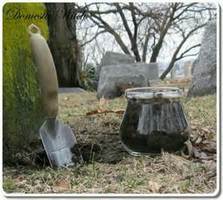 When you get there, place the candle on the grave and sit on top of it to meditate/pray with that spirit for a bit. Always ask for permission and assistance, and if you get an affirmative answer, begin to gather your dirt.
When you get there, place the candle on the grave and sit on top of it to meditate/pray with that spirit for a bit. Always ask for permission and assistance, and if you get an affirmative answer, begin to gather your dirt.Proper Payment
Take the graveyard dust from the appropriate area: over the head or feet for spells of persuasion, or if you want them to move in a certain direction; from the heart area for love. Cut out a small plug of sod, dig down about six inches for pure dirt without roots, and put a small amount in your sack or plastic bag. You won’t need more than a half-cup at most.
Then drop the silver dime into the hole in payment for the dirt, thanking the spirit and saying, “As I have paid you in silver, so shall you pay me in labor.” Add a bit of tobacco or whiskey (you may ask the spirit if it has a preference) into the hole and replace the plug of soil.
Write down the name, birth and death dates of the grave on a piece of paper and include it in the bag. Hold the bag in your hands and ask the spirit a last time to help you. Leave the candle (only if it’s in a fireproof container!), to burn on the headstone, and place the flowers on the grave.
Leave the grave knowing you have the spirit’s assistance, Walk slowly and don’t look back.
Thank all the spirits at the gate, and when you are outside, spin around three times before you leave, to confuse and detach any entities who may want to hitchhike home with you.
At home, spread the dirt out on a piece of foil to thoroughly dry, and then sift out any roots or rocks.
Store the dust with the name paper, and the moon phase when it was gathered. Every time you use it, call the spirit by name and command it to assist in your work, referring to the contract you made in the cemetery.
Shake Out Your Shoes
Graveyard dust is powerful magic and should never be used thoughtlessly, or without being clear about your intention, as well as any anticipated consequences. Some of its uses go against the Wiccan "harm none" belief, an edict that is not necessarily followed in all magickal circles. For instance, the mixture can be used for foot-track magic, a form of sorcery in which one influences, or even poisons a victim through the feet (ie, the graveyard dust mixture is sprinkled in the shoes of the victim, or on a path where the victim will walk).
Spells of revenge or retribution demand serious ethical consideration. Even if they do work, they often backfire on the user as well. You know, that darn karma….
Instead, consider using your graveyard dust to achieve your goals in a positive and non-manipulative manner.
Next Friday we'll continue the discussion, and I'll post an positive example: a spell using graveyard dust to get a fair inheritance.
Published on September 30, 2016 19:54
September 25, 2016
Why Yes, I Believe in Ghosts
 Do Ghosts really exist?
Do Ghosts really exist?I think they do, and not just at Halloween, although we may be more likely to see them during that season when the veil between the worlds is thin.
Maybe we're simply more likely to dwell on ghosts and the spirits of our departed as fall, the dark side of the year, descends upon us, and the season's growth slows, browns, and finally, dies.
The most popular explanation of ghosts are the departed souls of people who left this life abruptly, and still don't understand that they are dead. Others believe ghosts are those who have left some important thing undone in their life, or having suffered some great injustice, are sticking around to do that last chore or correct that injustice.
My favorite theory evolves from physics. If you think back to high school science lessons, you will recall that energy cannot be destroyed, only converted to some other form. People are bundles of energy, so I ask you: what happens to that energy when a person dies?
If energy doesn't die with the human body, but is instead converted to something else…where does it go? And what does it look like?
There are as many theories as there are religions on earth, plus some that have nothing to do with a religious leaning. Those who believe in ghosts think that all or part of that energy remains on earth, albeit in a different form. Since I also believe in reincarnation, I not only accept the presence of ghostly energy, but also imagine a living pool of energy, blended spirits of human, plant and animal, circling throughout the cosmos, with new life syphoned from it constantly.
But, to get back to earth—the energy present in a person's home is the result of all the energetic beings within it. The people (and pets) who live in a certain home eventually imprint that structure with their energies. Have you ever walked into someone's house and immediately felt welcomed and happy? Believers would say the occupants' positive energies are part of the house. On the other hand, consider a home where there was a murder, a suicide, or some other violent episode—even a contentious divorce. That turbulent energy could cause a house to become haunted.
I confess, once a paranormal writer accepts the possibility of ghosts, so many scene possibilities arise (pun intended).
First encounters with a ghostly entity, even a friendly one, can be terrifying, as the main character in my book, Song of the Ancients, discovers, when the veil between the worlds is parted during a Samhain ritual on All Hallows' Eve:
The man in the circle knelt beside a mound of dirt, digging his hands deep, cupping the soft red earth in his palms as he stood and began to chant.
"Dust to dust,
The rocks in time dissolve
Into the oneness of the Universe.
I call forth the Ancient Ones
To join us and impart their wisdom."
He raised his arms in front of him and parted his fingers, allowing the soil to fall between them to the ground.
I watched as the soil began to swirl like a tiny dust devil in a powerful wind. Dozens of ghostly dust plumes formed around him, nearly filling the circle.
Again he raised his eyes to the dark sky, moving his arms in a sweeping motion, as if catching and gathering something. He yelled, to be heard above the noise of the swirling dust and sand:
"At this time the veil between the worlds thins.
The gates are thrown open.
I welcome the spirits who have gone before,
The Others who pass between the two worlds.
Ancestors of old, arise now!
Join the human bridge awaiting you!"
From the shadows cast by the flickering fire, I watched one of the dust devils separate from the others and spin toward me. Its outline changed. I stared at the top of the swirl, and two glowing eyes stared back. An arm formed, then a second, reaching toward me.
The air in the circle became unbearably hot. I wiped sweat out of my eyes, and was slammed with a vision of the person inside the dust, so clear it stopped my heart for one terrified beat. This can't be happening! The wraith bore the face of my mother, dead for three years.
I tried to get away, but me feet tangled with the woman on my left. The ghost grabbed for me, raking the back of my hand with her fingernails. I screamed, sucking my breath in ragged pants. She reached for my face with both hands, but I scrambled away from her outstretched arms.
The ghost stepped back, her eyes filled with sadness. Terror gripped my mind like a vise. I could think of nothing but escape. I flailed and kicked and crawled from the circle until I could stand, and run.
What do you think about ghosts, souls, energy and reincarnation? I would love to hear from you.
Published on September 25, 2016 16:24
September 2, 2016
Research is Half the Fun
 Above - Border fence between Mexico and Arizona at Naco
Above - Border fence between Mexico and Arizona at NacoErnest Hemingway said writers should develop a built-in bullshit detector. I believe the best readers already have their own BS radar. You can tell when a writer is winging it. As a reader, you don't have to believe the story really happened, but you must believe it could have happened.
That's why I always begin my writing process with research, and continue researching clear through the final draft. It's fun to find that little detail that gives a scene the ring of verisimilitude—the feeling that the story's world is absolutely and unquestionably real.
I love to research locations, and I do that early on. For example, the suspense novel I'm writing now involves human smuggling across the Mexican border into Arizona.
After the 2001 terrorist attacks, the U.S. Border Patrol doubled in size to nearly 21,000 agents, most of them stationed along the border with Mexico. That's roughly nine agents for every mile of border from Texas to California. Couple that with fences now dividing the border for miles at all the major crossing points, and the Coyote smugglers are forced to move their human cargo and drugs across more remote and dangerous geographic areas. Arizona's Sonoran desert is one of the busiest--and deadliest--border crossing routes.
So I've been poring over topographic maps and using Google Earth to virtually roam the route my Coyote smuggler will force his customers to walk to their meet-up point. It's a scorching, desolate and arduous route, with summer temperatures topping 115 degrees, so they only travel at night.
Interestingly, I found during my research that the smugglers outfit the illegals almost as if they used an assembly line: Same brand and style of backpack, same contents, even the same amount of water—and never enough, so the travelers will be dependent upon their guide. In my story, one of the characters in the border crossers is a drug mule for the Sinaloan Mexican cartel, so sentries are posted along the route to track his progress. But they're not there to assist, only to monitor. Sometimes to ravage. From that fact, came the little jewel of a scene I'm posting as my first "Teaser Tuesday" post. Please come back on Tuesday and read it!
I'm renewing my passport now, and this winter my photographer husband and I will travel south to visit the locations I'm writing about on both sides of the border. The town of Naco is tiny on the Arizona side, but a bustling border crossing site on the Mexican side. And Bisbee, where my main character, Rumor Vargas (remember her from my last book? She was Samantha's business partner), has her antiques store, is already one of my favorite places. While I say there will be no paranormal element in this story, after the haunted sites tour in Bisbee, who knows?
It's the physical location visit that really "seals in" the details—especially sensory details like the way things sound, smell, and look in the actual setting. The hubby will take photographs and I'll take notes. If you are familiar with the book's settings, I encourage you to let me know if you spot any mistakes in the details of your favorite locations!
As an author, the hardest part is making sure the research doesn't take over my writing time, especially with the Internet making the world so very accessible. Hours (days!) can go by while I'm happily browsing, and not one word of the book actually gets written. That's the paradoxical truth about research: While it is absolutely essential, research isn't the story. The story must come from within. From the heart. For me to get into the "flow" requires extended periods of uninterrupted concentration, or wakeful dreaming. It's not an easy state to enter into and maintain. It must be protected.
To keep from getting lost in research, I set the kitchen timer. When the timer goes off, I stop—no matter how enticing that next search link looks. I go back to my blank page, and write. It's the only way to make a book. So, if I come to something I don't know, I insert square brackets [find out where in the high desert Saguaros quit growing] or [how much does a drug mule get paid per trip]. Then, if I get writer's block, or just need a break, I'll research one of the bracket questions, and that helps me get the writing juices flowing again.
Can you recall something an author researched so effectively that it pulled you into the story? Please share, I'd love to hear your examples.
Published on September 02, 2016 20:25
August 26, 2016
Using the Tarot to Write Your Novel
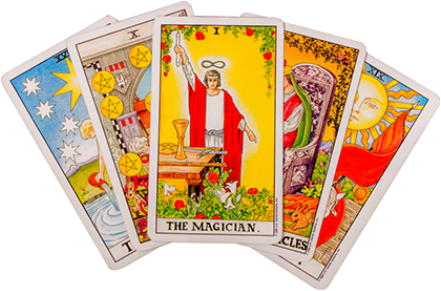
There's nothing more freeing, or more frightening, than facing a blank page to start a brand new creative writing project. So many possibilities. But where to start? And what if I run out of ideas half-way through?
With a tarot deck beside you, you won't be starting out with a blank page. Instead, you'll have a world of stories and subtext, character traits and interactions at your disposal. If you allow your creative juices to flow, the cards will bring those stories to your page.
Don't worry. You don't have to be an expert on reading the cards to use them as a creativity tool. Simply trust your instinct and allow your unconscious to express itself. The mythical symbols and archetypes are already embedded in the images of the deck.
Corrine Kenner, author of "Tarot for Writers" says well-known writers, such as John Steinbeck and Stephen King, have used tarot cards for inspiration. They can help you develop your plot, conflict, character profiles, dialogue and scenery, as well as to introduce unpredictable elements. The cards can even jog your creativity if you run into a "block" in the middle of a story, by taking the open ended images on the cards and projecting a story into them.
The Basics
A tarot deck consists of two parts: the Major Arcana and the Minor Arcana.
Major Arcana
The 22-card Major Arcana represent universal archetypes, the basic patterns for human thoughts and emotions, often dramatic, life-changing events. For example, the Chariot
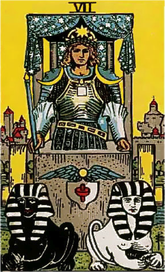 card is all about decisive movement, will power, dominance and personal victory. If you draw this card while trying to decide the direction your male main character is going to take next, it could mean that he is currently controlling a situation through sheer force of will, and it's made him overconfident. Maybe it's time to present him with a setback that teaches him the end doesn't always justify the means, or convinces him it's time to learn compromise.
card is all about decisive movement, will power, dominance and personal victory. If you draw this card while trying to decide the direction your male main character is going to take next, it could mean that he is currently controlling a situation through sheer force of will, and it's made him overconfident. Maybe it's time to present him with a setback that teaches him the end doesn't always justify the means, or convinces him it's time to learn compromise. The Justice card, on the other hand, is about legal matters and equilibrium, as well as forgiveness and karma. If you drew this card for your male lead, he may be a forgiving soul who excuses bad behavior and gives people a second, maybe even a third, chance to redeem themselves.
The Justice card, on the other hand, is about legal matters and equilibrium, as well as forgiveness and karma. If you drew this card for your male lead, he may be a forgiving soul who excuses bad behavior and gives people a second, maybe even a third, chance to redeem themselves.In either case, draw a second card before you begin to delve into meanings. It's fun to work in pairs, to find the yin and yang of the characters in your story.
We'll come back to that topic in a moment, but first let's look at the rest of the tarot deck.
Minor Arcana
There are 56 cards in the Minor Arcana. While the Major Arcana portrays big, universal themes, the Minor Arcana brings those themes down to the street and applies them to everyday life. The Minor Arcana has four suits—typically labeled Wands, Cups, Swords and Pentacles. Each of those suits has ten numbered cards and four Court cards (King, Queen Knight and Page, or something similar). Each tarot suit corresponds to one of the elements: Fire, earth, air and water.Wands=Fire. Could be a fiery personality, tempers flaring, or positive enthusiasm and change.
Pentacles=Earth. Wealth, or the flip side and money troubles. Commerce and property. Stuff you can touch and hold.Swords=Air. An intellectual person using words as a weapon. Conflicting ideas. Even worry and pain.Cups=Water, and all the emotions and intuitions that come with it. Also the all-important relationships and romance.
As a writing example, let's go back to your male protagonist in the Major Arcana section above. You pulled the Justice card for his first draw, and have decided he is big on forgiveness and second chances. Then you draw the second card, the 3 of swords.
 Looking at the two drawn cards together gives you a deeper picture of your hero. Yes, he forgives others readily. But those three swords through the heart indicate that he is not nearly so forgiving with himself. He's plagued by paralyzing regret and guilt about his own past. What in his past has caused such pain? That backstory is up to you.
Looking at the two drawn cards together gives you a deeper picture of your hero. Yes, he forgives others readily. But those three swords through the heart indicate that he is not nearly so forgiving with himself. He's plagued by paralyzing regret and guilt about his own past. What in his past has caused such pain? That backstory is up to you.Conclusion
Using the tarot to write your novel is about trusting yourself and allowing your subconscious to express itself. Pick a card and set it in front of you. What’s the first image that you notice? What do you think it means? Do you get an overall impression from the image as a whole? What thoughts or feelings emerge? How can you apply it to your novel? Free write without censure or editing, and see what happens.
This process can be used regardless of the genre of your novel. I'd recommend researching tarot decks online or at a local occult or New Age store, to find a deck that reflects your particular genre or "speaks" to you. I've included but a few samples of the diverse artwork on tarot decks. Thousands of samples are available, and the search for your personal author's deck is half the fun.
For more information on creative writing using tarot, leave me a question here. I'd also recommend you pick up a copy of "Tarot for Writers" by Corrine Kenner for many more ideas on how to get started.
Published on August 26, 2016 17:15
August 18, 2016
Black Bird Magic
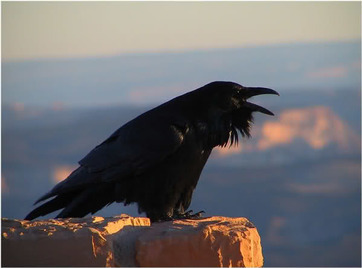 A trio of crows gather in the Ponderosa pines behind our forest cabin. We’ve grown accustomed to waking to the whomp, whomp of those huge wings every sunrise, and their raucous chatter at us as we eat breakfast on the back deck.
A trio of crows gather in the Ponderosa pines behind our forest cabin. We’ve grown accustomed to waking to the whomp, whomp of those huge wings every sunrise, and their raucous chatter at us as we eat breakfast on the back deck. Ravens and crows belong to a family of birds called corvids. Ravens are bigger than crows, and they tend to be shaggier looking because of the fluffy scruff on their breast. But the easiest way to tell a raven from a crow is by the bill and the tail. The crow’s bill is sharp and short; the raven’s is slightly hooked. The tail of a crow in flight is cropped, while the raven’s is a diamond shape. A crow speaks in a harsh, loud “caw,” while the raven’s call is a softer, “kruk,” or even a chuckle.
Ravens and crows both eat a varied diet, but they prefer carrion. They are often companions of the coyote and wolf, working with the pack. A wolf, with claws and teeth, can tear open a fresh kill for the birds, who patiently wait their turn. In exchange, ravens fly ahead of a hunting pack and lead them to a potential victim.
I love corvid medicine and I’m happy it’s in my life. When I first began to study witchcraft, the raven was the first animal guide to appear to me in meditation, and the living birds were everywhere: on camping trips, hikes, scavenging in dumpsters, even nested in the stadium lights at my son's high school football field.
I’ve written several scenes including ravens in my novel, Song of the Ancients.
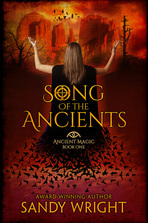 My Lakota medicine man character, Sinclair, can shapeshift into a raven, and he carves a protection totem for my protagonist, Samantha, that has a raven’s head and wings atop a woman’s torso.
My Lakota medicine man character, Sinclair, can shapeshift into a raven, and he carves a protection totem for my protagonist, Samantha, that has a raven’s head and wings atop a woman’s torso. I'm interpreting the bird’s presence en force in my life as a sign that those scenes are on track.
These intelligent and mysterious birds are powerfully associated with witchcraft and magic. Unfortunately, they’ve also developed a rather sinister reputation as harbingers of death. Granted, part of that reputation is earned.
The ancient Celts associated ravens with The Morrigan, Goddess of death and battle, and also a shapeshifter. When warriors saw a raven on the battlefield, they knew The Morrigan was watching…waiting to mark the dead.
The History Channel’s series “Vikings” features the Norse God Odin’s two ravens in its opening credits. Their names are Huginn (meaning thought) and Muninn (meaning memory). These ravens are not just Odin’s pets; they are his informants, roving the upper and lower worlds to observe and report back at sunset. Viking leader Ragnar Lodbrok had a banner embroidered with a raven. It was said if this banner fluttered Lodbrok would carry the day, but if it hung lifeless the battle would be lost.
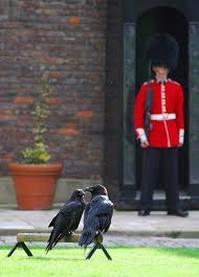 According to legend, the Kingdom of England would fall if the ravens in the Tower of London were removed. During the Second World War, most of the Tower’s ravens perished during bombing raids, leaving only a mated pair, Mabel and Grip, who also flew away to escape the loud explosions. Since the Empire was dismantled shortly afterward, those who are superstitious say history confirms the legend.
According to legend, the Kingdom of England would fall if the ravens in the Tower of London were removed. During the Second World War, most of the Tower’s ravens perished during bombing raids, leaving only a mated pair, Mabel and Grip, who also flew away to escape the loud explosions. Since the Empire was dismantled shortly afterward, those who are superstitious say history confirms the legend.Just to be safe, before the tower reopened to the public in 1946, raven residents were re-established. Six ravens currently reside at the Tower. To prevent the birds from flying away, their feathers are trimmed by the royal Raven Master (no, it doesn't hurt them). They are fed raw meat and biscuits soaked in blood, as well as eggs and the occasional rabbit (fur and all). Despite the trimmed wing, some ravens do in fact go absent without leave and others have had to be sacked. Raven George was dismissed for eating TV aerials and Raven Grog was last seen outside an East End pub.
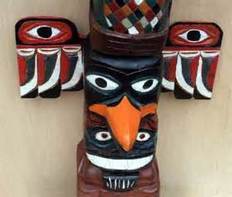 Many Native Americans see both crow and raven as tricksters, much like the mystical coyote, except the tricks usually end with a positive result. Many tribes honor raven for bringing light to mankind, and they are a common feature on totem poles.
Many Native Americans see both crow and raven as tricksters, much like the mystical coyote, except the tricks usually end with a positive result. Many tribes honor raven for bringing light to mankind, and they are a common feature on totem poles.For me, these birds do not represent physical death, but the end of an outgrown way of being, a rigid or deprecating belief that is creating an obstruction in my life. This process is called “the resolution of opposites.” The presence of either glossy black bird says I am being urged to resolve a deep and long-seated conflict in my psyche.
In magic, Raven and crow bring different messages. Raven speaks of the process of life, death and continual change. It signals the end of one part of life and beginning of something new. Crow addresses the magic within everyday life and reinforces the laws of the Creator.
If a raven guide appears to you, turn your focus inward. He is guardian of our fears, and to see one in a dream is a message it’s time to examine what scares you. He will show you how to go into the dark of your shadow self and bring out the light, resolving inner conflicts that have long been buried.
Everything has its own energetic spirit, including negative self-talk. Consider any negative thoughts you hold about yourself. Is it a long list? “I don’t measure up.” Or, “I don’t have the talent/drive/money/time to do what my heart desires.” Or, “they’ve never loved me. I’m a disappointment to them.” What energy is creating these disabling beliefs? What new action will dispel them?
Just as the raven is often a silent observer, you may need to observe your environment, the people in it, and your own actions and attitude, to discover the true source. Your behavior is a deep and complex tapestry woven over the expanse of your entire lifetime, so don’t expect change overnight. It takes time to untangle the knots you’ve spent years making. But that’s what raven magic is all about.
Crow is the guardian of ceremonial magic and healing, and he will be present around any healing circle. Crow guides you to improve your physical environment, such as enabling you to dispel “dis-ease” or illness. He is also the sacred keeper of the law, indicating you have an instinct for right and wrong beyond the laws created in human culture. With crow as your totem, you must be willing to walk your talk, to speak your truth, to know your life’s mission, and to balance past, present and future in the now. Put aside your fear of being a solitary voice and “caw” the shots as you see them. When you learn to allow your personal integrity to be your guide, your sense of isolation will vanish.
Beware of converting completely to the outlaw however. If you rebel simply to break rules, the only loser is you. If you are lying to yourself on any level, you are ‘eating crow.’ Contrary crow reminds us that Divine Law is NOT simply passing judgment. Divine Law in magic is having an open and forgiving heart, a true tongue, a respect for all living creatures, and a peaceful mind.
To understand the flight and call of raven or crow, listen for their song near dawn or in the late afternoon. Enter a place of stillness within to hear and accept what they have to tell you.
Published on August 18, 2016 16:56
January 31, 2016
Writing After Stroke
 I am wandering the opposite side of the city from my home, lost but not worried. I've been wandering for a couple of hours, slowly tightening the circle to downtown Phoenix. My destination is the home of an acquaintance I've visited dozens of times. Why I'm having so much trouble finding it this time I don't know, but I'm not worried. I do wish, however, I hadn't left my cell phone at home on the charger. At the next red light, I check my purse again for the phone's familiar bulk. No luck. Oh well….
I am wandering the opposite side of the city from my home, lost but not worried. I've been wandering for a couple of hours, slowly tightening the circle to downtown Phoenix. My destination is the home of an acquaintance I've visited dozens of times. Why I'm having so much trouble finding it this time I don't know, but I'm not worried. I do wish, however, I hadn't left my cell phone at home on the charger. At the next red light, I check my purse again for the phone's familiar bulk. No luck. Oh well….I should be terribly worried.
At home, finally, I retrieve my phone to see a half-dozen messages from my husband. The last one says, "Where ARE you? We gave up and went to dinner. Home in a few hours." I toss the phone on the counter, mumbling, "Thanks a lot." I have a throbbing headache, probably a result of the cold and sinus infection I've been fighting for a week. But I'm on antibiotics and prednisone, so surely it will get better soon. I take some Ibuprofen and lay down for a nap.
When my husband wakes me, it is dark. Still sleepy, I mumble a reply to his hello, run a hot bath, and sink into the steamy water. Maybe that will help my headache, which has moved into my left eye socket.
An hour later, my son cracks the bathroom door. "Mom, when you get out, could we talk?" We'd started a stressful disagreement before I'd left that morning. I've been crying on and off since he arrived home for Thanksgiving break two days ago. Now, sitting in the tepid bathwater, I begin to cry again. I feel too bad to argue further. "I don't feel right," I tell him. I have trouble getting the sentence out.
The next day is Thanksgiving. We have dinner reservations with friends. I take more Ibuprofen and get dressed. When I relate my symptoms and experiences of the last two days to our friends over dinner, my cousin says, "Please, Sandy. Go by the Urgent Care after dinner."
We drive by the Urgent care center on the way home. Since it's Thanksgiving night, business is slow and I'm admitted to a room immediately. I struggle to complete the paperwork, and my husband takes the clipboard out of my hands and fills it out for me.
The ER nurse takes my blood pressure, and the doctor asks me to describe my headache, which has settled at the back of my skull in addition to my right eye. "Say 'No ifs, ands or buts,'" he instructs. I give a garbled reply, and my husband shoots me a look of concern.
"You've had a stroke," the ER doc says brusquely. "Let's get you in for a CAT scan."
"Transport?" the nurse asks, and he nods. "There's a bed available at Chandler Regional."
* * *
A stroke occurs when blood flow to an area of the brain is deprived of oxygen when a clot occurs. When brain cells die during a stroke, abilities controlled by that area of the brain, such as memory or speech are lost. How a person is affected by their stroke depends on where the stroke occurs in the brain and how much of the brain is damaged.
Most of the cells in our bodies die and are replaced every few months. However, neurons—the primary cells of the nervous system, do not regenerate or multiply after we are born. That means that the majority of the neurons in your brain today are as old as you are. This longevity of the neurons partially accounts for why we feel pretty much the same on the inside at the age of 10 as we do at the age of 60.
If brain cells do not regenerate, can one recover from the damage of a stroke?
Consider a busy Chinese restaurant. People are getting their orders taken and yelled into the kitchen, others are being seated. Plates are clattering and food is being eaten. It looks like chaos, but everything gets done.
Your brain is like that busy Chinese restaurant. As new connections are made in the brain, different answers, different perspectives, and different solutions to problems are created.
There are approximately 100 billion neurons (nerve cells) in the brain. A typical stroke kills less than 2 billion neurons. But those numbers are small compared to the number of connections between neurons in the brain. The present estimate of connections between neurons is an astounding quadrillion (a thousand trillion). Hard to imagine, but good news for stroke survivors. The number of connections between neurons in more important than the number of neurons themselves. Forging new connections between neurons that survive after a stroke is the basis for recovery.
And that's where the concept of neuroplasticity—and this blog—come in.
Neuroplasticity is the brain's ability to adjust to trauma and rewire itself. Rewiring the brain after stroke requires hard and focused work. But if a skill is developed with the right intensity it will promote lasting change in the brain. The saying among scientists who examine how the brain works is "neurons that fire together wire together." We are what we repeatedly do. The more times we repeat a specific action the more thoroughly the brain learns that action.
For me, that's writing.
I haven't resumed work on my new novel since the stroke, but I'm ready to take that big step. After two months of cognitive therapy and my own personal research, I've decided to try a combination of distributed and mass writing practice: Relatively short two-hour writing sessions each morning Monday through Thursday, with more intensive 5-hour day on Friday.
I will be blogging my progress—good and bad, on my personal blog, as well as information from my ongoing brain research. Join me, please, and leave your comments and questions on all aspects of writing or the brain. I'll post a short excerpt from my novel-in-progress, Stones of the Ancients, starting next month.
Published on January 31, 2016 23:27
October 18, 2015
Souls' Reunion
 We walk onto a darkened patio dimly lit with flickering candles. A small incense jar burns by the door, wafting the sweet citrus scent of copal. Ahead stands an altar decorated with skulls, tiered crystal balls and a scattering of tea lights for guests to light in remembrance of loved ones who have passed.
We walk onto a darkened patio dimly lit with flickering candles. A small incense jar burns by the door, wafting the sweet citrus scent of copal. Ahead stands an altar decorated with skulls, tiered crystal balls and a scattering of tea lights for guests to light in remembrance of loved ones who have passed.“Did you bring photos?” a woman asks, her gorgeously wan body draped in clothes like dark cobwebs, her skin powered ghostly white.
I brought a picture of my mother when she was about my age. She was photographed from behind, walking on the ties of a railroad track, her hands reaching out to the sides for balance. Just as the picture was snapped, she had turned her head to smile at the photographer – my father, I assumed. It was my favorite picture of her, and three years ago I had placed it by her casket at the funeral.
We leave them on the altar, already crowded with pictures. I study the faces in the photographs. The children hit me the hardest. Sweet little lives cut short, memorialized on photo paper.
Faintly, in the background, a drum marks time like a heartbeat.
A book in the center of the table is titled “Ledger of the Dead,” and several names are already listed on the open page. I write ‘Nancy Campbell, beloved mother’ below the other names, surprised to notice my hand is trembling. Is it possible she will actually show up? And what does one say to a ghost? Should I tell her what’s been going on in my life, or can she see me and my life through the veil?
In the middle of the dark back yard is a large circle of autumn leaves and cornstalks, punctuated by torches. We line up outside the circle and two people walk down the line, one fanning smoke onto us from a smoldering sage bundle, the other anointing our foreheads with scented oil. I draw a deep breath of the wonderful aromas, feeling the tense muscles in my shoulders unknot and release.
Quietly we step up to the circle. A woman in a black dress and veil hands us each a silver dollar as we enter.
The Priestess raises her dagger and points it at each of the flames flanking the circle, making them pop and crackle. “Bless this space and the spirits who come to visit.” The embers rise and orbit round us like tiny moons, tumbling and floating, until we are all contained within a cone of golden light.
“As above, so below!” The Priestess cries. “This circle is sealed!” The embers drop to the ground with a final sizzle.
Inside the circle, it is so quiet I can hear my own breathing. I immediately feel warmer. Is excitement raising my blood pressure, or am I truly cocooned in protected space, a time outside of time? Every sense seems more acute, yet at the same time stilled. I smell the pungent incense, hear the tree leaves rustle, pick out every detail of the dozen or so candlelit faces across the circle.
We listen to readings about the final harvest, the earth going dormant. With my heightened awareness, I can actually sense the earth drowsing beneath my feet, waiting for the warm spring sun to return. I have never been so alive, or felt my own mortality so acutely. A chant begins.
“The Moon is bright, the Crone is old,
The body lifeless - the bones so cold.
We all live and pay our dues
To die in ones and threes and twos.”
Witches believe that at Samhain, or Halloween, the veil between the worlds of the living and the spirits is at its thinnest, and the dead can visit their living families. Communion is safest in a magical circle, cast to both contain energy and to protect those within.
“Behold, the Western Gate is now open, let us pass through!” calls our Priestess.
We join hands and walk round and round, spiraling, descending to the Underworld, chanting as we go:
“Come ye, good spirits of the dead!
Be ye spirit of plant or pet
Or human spirit that we have known,
Into this Circle you are let!
Speak to us of things unknown!
Lend your energies to this rite!
To speed your journey, we have joined
On this Sacred Samhain night!”
The spiral tightens and the chanting quickens, then gentles and goes silent. The torches have been extinguished. Darkness surrounds us.
We have arrived. It’s time to pay Charon the Boatman and be ferried across the River Styx to visit our ancestors. We each hand a coin to the black-robed figure who traverses the circle in silence.
Piling our hands on the black leather-bound book in which we signed the names of our deceased, we speak their names aloud—who they were to us, how they died. My father, a burst aneurysm, Karen’s friend, cancer. Your mother, heart attack. Another mother, a sister, best friend, uncle, track coach, favorite pet.
The names multiply and tumble over each other until they are swirling around us like tendrils of memory fog. One woman cremated her father three days before. Tears pour down her face, and we drape our arms on each other’s shoulders in a communal embrace. We share family news with our loved ones, love and laugh, and say words we may not have had the time or the heart to say while they were alive.
Our twenty minutes pass too quickly. It’s time to say farewell.
While the Priestess finishes our memorial, I close my eyes, blinking away tears. Of all the unusual things I have done since choosing the Witch’s Path, communing with my mother’s spirit this evening is the easiest. I dropped my guard, suspended any last vestiges of former beliefs, and was simply comforted by her presence. Why did I ever question if she would show up? Love guided her back to me, as it will on this night every year.
We stop at the ancestor’s table to pick up our mementos, but leave the candles to burn out in their own time.
I kiss my fingertips and caress each skull. Blessed be all, I whisper to those souls. The candles flicker for a moment.
Silently, we file past the table, back into the world of the living.
Published on October 18, 2015 13:22
October 8, 2015
Monsters Around Us
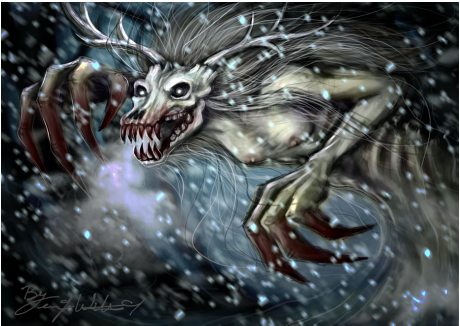 I believe in monsters.
I believe in monsters.The existence of monsters was proven to me again last week, when a shooter, an 18-year-old student, killed another student on my son's college campus, and wounded three others.
Whatever the shooter's motivations for killing, it drove home, very close to home, the fact that our species homosapien walks a thin line between functioning and out-of-control creature.
While the above event had not happened when I wrote my first book, Song of the Ancients, sadly similar scenarios play out around the world every year. Psychopaths. Road Rage. Religious zealots. Terrorists.
How does an author write a human monster? Start with an everyday human. Then give him an acute stress. Or a rigid belief. Or make him a functioning sociopath, and then twist him.
In my book, the monster is witch-gone-to-the-dark side Nuin Ash. He's trying to open a portal in a Sedona vortex sealed for centuries, release his demon Lord from the Underworld, and loan that demon his human form.
There's the twisted thinking.
How can Nuin make himself strong enough to withstand demonic possession? By stealing power from other witches. Since a witch's power resides in the blood, he is killing the most powerful witches he can find and eating their flesh.
There's a name for a monster like Nuin: Wendigo.
Legends of this creature date back for centuries, and have almost always been associated with the act of cannibalism. In fact, one persistent tale details the Wendigo’s origin as being that of a human who was forced to resort to consuming his peers (no doubt in an unfortunate Donner Party-esque situation) in order to survive a particularly brutal winter.
The problem with Nuin's plan, of course, is that once he delves into dark magic, it consumes him. The man becomes the monster, driven to hunt and hurt people without remorse. The classic definition of a sociopath, this time driven to the extreme.
I think the most memorable killers in fiction are sociopaths, able to mask the monster within, at least initially. And the most frightening monster is that which is indistinguishable from madness. So it is with Nuin. In his own selfish need for power, he gives in to darkness and abandons his humanity.
Here's an excerpt, where Nicholas Orenda, the man hunting the killer, gets his first clue about the monster he is after:
Why would someone sneak into a cemetery and bury a body? He could think of a number of mundane reasons, but why would a witch do so? Unless he defiled the body and didn't want anyone to know. His hole grew deeper and his unease increased.
Only three feet down his shovel hit something firmer than the soft soil, connecting with a muffled thud. Digging carefully down one side, he cleared a space to stand beside the box. He removed the crowbar from his sack and pried the coffin nails from one side, muttering softly, "Coffin nail, familiars of maggots unsavory creatures of the kind. Do my bidding, my evil works, when I so command." Blowing on the nails, he pocketed them and opened the lid.
He held his breath and shone the flashlight on the body, a young woman, barely past her teens. Her hands had been folded on her chest. He ran the flashlight further down, illuminating several places on her right arm where jagged chunks of flesh were missing.
Burning bile rose in his throat, making him gag and cough. "Something chewed on this girl. Oh, Goddess, tell me she died first."
Yes, there's also a demon in the story. But I think Nuin is the scarier of the two. He's a handsome, flirtatious, functioning human going through the motions of everyday life.
Until he's not.
This week proved, once again, he's not alone.
Published on October 08, 2015 13:24
October 7, 2015
August 16, 2015
Poison Your Pretties

If you write enough novels, the question will come up: Shall I kill a favorite character or let him/her live?
There's always a risk. George R. Martin has offed so many of his characters that some people now refuse to follow the series in books or on HBO. He lost another batch of followers when he ended this season with the cliff-hanger group execution of the Night's Watch Commander Jon Snow. I loved Jon Snow, and am firmly in the camp that believes we haven't seen the last of him. Since Martin has given HBO permission to write their scrips ahead of his books, I'm clinging to hope for the series at least.
But there's no denying a death ratchets up the tension, especially if the victim is a beloved character in which the reader is emotionally invested. Does that sound cruel? Maybe, but the more closely you know a character—the more believable and developed a character is—the more you want the responsible party to pay for that character’s death.
Consider Sirius Black in the Harry Potter series. The death of Harry’s much-maligned godfather not only redeemed him, but made readers turn more strongly against his killers. It showed, rather than told us, the antagonist’s capacity of evil, which further aligned us with the main characters. Of course, when Professor Snape killed beloved Headmaster Dumbledore, the majority of readers closed The Half-Blood Prince heart-broken and deeply hating the surly potions master.
I didn't. In fact, that book spurred me to write my own novel and create a character who, like Snape, battles his own darkness while fighting the good fight.
Enter Nicholas Orenda. His life as a magical bounty hunter, chasing the most adept of the world's dark magic practitioners, has turned him cynical. In the scene from Song of the Ancients, he is suspicious that the protagonist, Samantha, is actually in cahoots with the bad guys. Because I always think it’s fun to add an exotic poison to a story line, Nicholas decides to find out by giving her wine tainted with the poison Aconite, found in the Monkshood plant:
I watched his long fingers curl around the bottle. His movements were practiced, but his hand trembled slightly. He uncorked the bottle and poured the rich red liquid into two glasses, offering one to me.
“To fate.” He toasted with a tight smile.
I brought the glass to my lips and let the wine settle in my mouth. It tasted of raspberry, chocolate and oak, as well as something slightly bitter.
Nicholas looked ill. He set his glass down without tasting it.
“Do you have plans for New Year’s Eve?” I handed him the gallery show card. “You said you’d like to meet Standing Bear.”
He read the card and looked at me. “Is this a peace offering?”
“Of sorts.”
“I accept.”
He seemed genuinely accommodating. For the time being, it appeared we were to act civil with each other.
I began to relax and took another sip of wine. The alcohol was hitting me hard tonight. Already my face felt slightly numb. “Would you like to study first?”
“Yes, let’s.” He seemed distracted. “You said you have your Materia Magicka completed?”
I nodded. “I got it done while I was house-sitting.” Nicholas had suggested I do the research systematically. “I have them alphabetized.”
“Then let’s begin with ‘A’.”
I took a sip of wine and pulled out the first card. “Acacia. You can use the flowers or burn the wood to stimulate psychic centers or for money spells.”
Nicholas nodded. “It can be used for protection as well. A sprig of the tree over your bed wards off evil.”
I made a note of his comment and continued. “Aconite. It’s a poison, also known by the common names of Monkshood and Wolfbane. The entire plant is poisonous, especially the leaves and roots.”
“If ingested?” he asked.
“Yes, or from contact,” I added.
“Reaction time?”
This was harder. “Fifteen minutes to as long as a few hours.”
“Very good. Antidote?”
Uh oh. I hadn’t catalogued antidotes. I looked at the asterisk I’d put on the card beside the poison symbol. I had meant to go back and make additional notes on the poisons.
“I don’t know.” I had some trouble getting the words out. My mouth was numb and my lips felt swollen. I lifted my wine glass and looked at it. Still nearly full. I set the glass down, sloshing most of its contents onto the table.
“Then I believe we will both learn something tonight.” He leaned in to peer at me, his nose only inches from mine
I was beyond caring what he did. My face was now completely numb and a tingling sensation had taken over both of my arms, as if tiny insects were crawling on them. My skin was cold and clammy and my pulse was irregular and v-e-r-y slow. I wondered for a brief moment if it would stutter to a halt.
But my mind was perfectly clear as I watched Nicholas.
He looked at his watch and then put his fingers under my chin and looked into my pupils. “How are you feeling?”
I wanted to answer him, but my mouth wouldn’t form the words.
“It would appear the reaction time for ingested aconite is closer to the fifteen minutes you quoted.”
I wanted to scream for help. All I could do was stare at him with wild eyes.
“A one to fifty drop ratio of aconite is sufficient. When taken orally, as you did, it first stimulates and later paralyses the nerves. The initial tingling gives way to long-term anesthetic action. That is why your tongue and then your face became numb.”
He shifted slightly in his chair and lifted my arm, pressing his thumb to the pulse point on my wrist. “Aconite acts on the circulation, the respiration and the nervous system. The pulse slows, possibly as low as forty beats per second. Blood pressure falls and breathing becomes slower as the respiratory system is paralyzed. Death is usually due to asphyxia. Interestingly, as in strychnine poisoning, the victim is conscious and clear-minded to the last.”
He let go of my wrist. It flopped, useless, onto the sofa. “But you know all of that, don’t you?” His tone was pure ice. “Were you afraid I wouldn’t try the bottle you left on my doorstep, so you brought a second one just in case?”
He put his lips to my ear. “I want to know why you are trying to poison me. I want to know what Nuin and his cronies are planning. And I especially want to know your part in his little scheme.” He enunciated each word with deliberate slowness, but his matter-of-fact voice told me everything I needed to know.
I was going to die.
Aconite is a plant indigenous to many parts of the world, including most of the United States. All parts of the plant are poisonous, but the root is the most toxic. A half tablespoon of a tincture of aconite root placed in a bottle of wine or whiskey is enough to kill a large man. A tincture is an alcohol extract of the material. Placed in a drink, the alcohol goes unnoticed.
Even with today's advanced CSI testing, Aconite has been called “the perfect poison to mask a murder.” It can be detected only by sophisticated toxicology analysis using equipment that is not always available to local forensic labs, and then only if poison is actually suspected. Fans of the Harry Potter series will recognize it as Wolfsbane, the plant Professor Snape brews to help Remus Lupin when he transforms into a werewolf at the full moon. Legend is it got that nickname because Greek hunters used it on poison arrows to hunt wolves.
Poor Samantha forgot to research antidotes, but it wouldn’t have done her much good anyway. The only known antidote for Aconite is a purgative, like Ipecac, itself a poison which causes nausea and vomiting. Lucky for her, she only took two swallows of wine. And does Ipecac sound familiar? Check your medicine cabinet, you might have the syrup.
I confess I’m fascinated by the plant world’s criminal elements. There’s something so cold about poison. It seems exotic and foreign, yet many of these dark villains are growing in our own back yards, pastures and roadsides, or included in everyday remedies sold over-the-counter.
Next blog, we’ll move to the B’s and I’ll tell you some stories about Belladonna, the deadly Black Nightshade still used in eye drops, and which grows like a weed in Arizona.
Until then, don’t eat any berries off unknown bushes. And never be the first one to taste the wine.
Published on August 16, 2015 20:19



